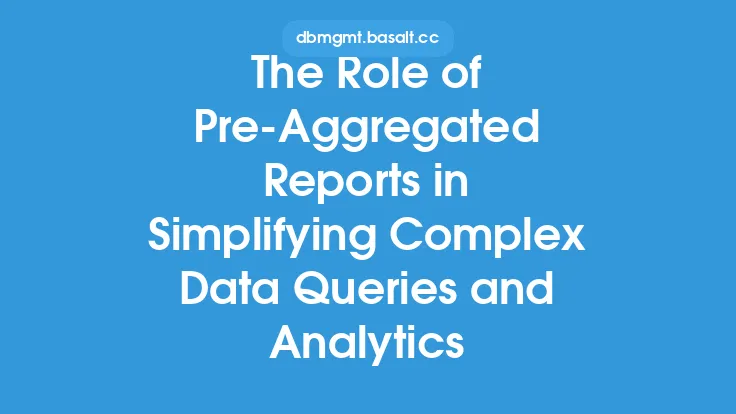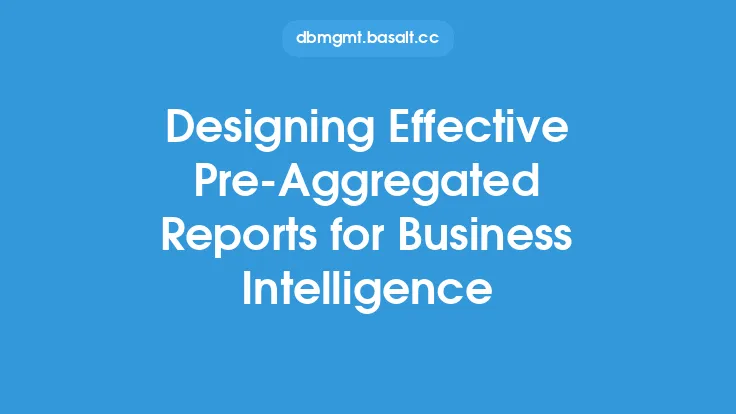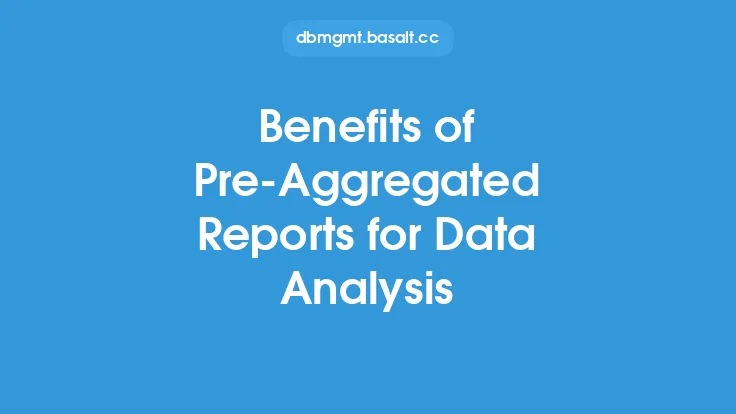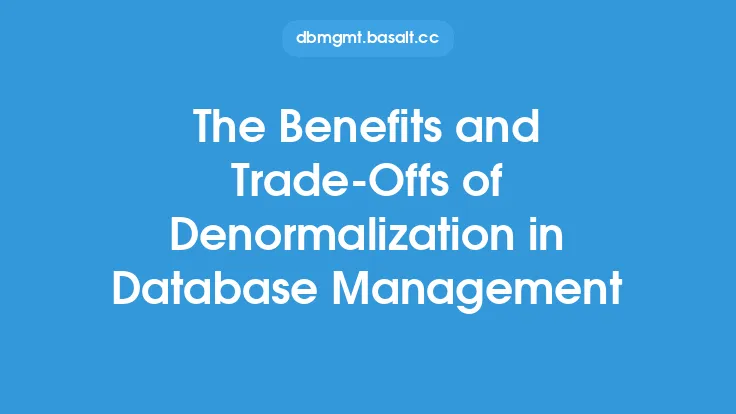In the realm of database management, data denormalization is a technique used to improve the performance of databases by reducing the number of joins required to retrieve data. One of the key strategies employed in data denormalization is the use of pre-aggregated reports. Pre-aggregated reports are a type of data storage that involves pre-calculating and storing aggregated data, such as sums, averages, and counts, in a separate table or data structure. This approach allows for faster query execution and improved data insights, as the aggregated data is readily available and does not need to be calculated on the fly.
Introduction to Pre-Aggregated Reports
Pre-aggregated reports are designed to reduce the computational overhead associated with aggregating data at query time. By pre-calculating and storing aggregated data, databases can avoid the need to perform complex calculations, such as joins and subqueries, which can slow down query execution. Pre-aggregated reports are particularly useful in scenarios where data is relatively static, and queries are repetitive, such as in data warehousing and business intelligence applications.
Types of Pre-Aggregated Reports
There are several types of pre-aggregated reports, each with its own strengths and weaknesses. Some common types of pre-aggregated reports include:
- Rollup reports: These reports involve pre-aggregating data at multiple levels of granularity, such as daily, weekly, and monthly.
- Drill-down reports: These reports involve pre-aggregating data at a high level of granularity, with the ability to drill down to more detailed data.
- Summary reports: These reports involve pre-aggregating data to provide a summary of key metrics, such as totals and averages.
How Pre-Aggregated Reports Work
Pre-aggregated reports work by creating a separate table or data structure that stores the pre-aggregated data. This table is typically updated periodically, such as nightly or weekly, to reflect changes to the underlying data. When a query is executed, the database can use the pre-aggregated data to quickly retrieve the required information, rather than having to calculate it on the fly. Pre-aggregated reports can be implemented using a variety of techniques, including materialized views, aggregate tables, and data cubes.
Benefits of Pre-Aggregated Reports
Pre-aggregated reports offer several benefits, including improved query performance, reduced computational overhead, and improved data insights. By pre-calculating and storing aggregated data, databases can avoid the need to perform complex calculations, which can slow down query execution. Additionally, pre-aggregated reports can provide faster access to data, as the aggregated data is readily available and does not need to be calculated on the fly.
Challenges and Limitations of Pre-Aggregated Reports
While pre-aggregated reports offer several benefits, they also present some challenges and limitations. One of the main challenges is the need to maintain the pre-aggregated data, which can be time-consuming and resource-intensive. Additionally, pre-aggregated reports can be inflexible, as they are designed to support specific queries and use cases. If the underlying data or query patterns change, the pre-aggregated reports may need to be updated or recreated, which can be a complex and time-consuming process.
Implementing Pre-Aggregated Reports
Implementing pre-aggregated reports requires careful planning and design. The first step is to identify the queries and use cases that will benefit from pre-aggregated reports. Next, the database administrator must design the pre-aggregated report, including the data structure and update frequency. The pre-aggregated report must then be populated with data, which can be done using a variety of techniques, such as ETL (extract, transform, load) processes or data integration tools. Finally, the pre-aggregated report must be maintained and updated regularly to ensure that it remains accurate and relevant.
Best Practices for Pre-Aggregated Reports
To get the most out of pre-aggregated reports, database administrators should follow best practices, such as:
- Identifying the most frequently executed queries and designing pre-aggregated reports to support them.
- Using a combination of pre-aggregated reports and other data denormalization techniques, such as indexing and caching.
- Regularly maintaining and updating pre-aggregated reports to ensure that they remain accurate and relevant.
- Monitoring query performance and adjusting the pre-aggregated reports as needed to optimize performance.
Conclusion
Pre-aggregated reports are a powerful technique for improving database performance and providing faster access to data. By pre-calculating and storing aggregated data, databases can avoid the need to perform complex calculations, which can slow down query execution. While pre-aggregated reports present some challenges and limitations, they can be a valuable tool for database administrators and data analysts. By following best practices and carefully designing and implementing pre-aggregated reports, organizations can improve query performance, reduce computational overhead, and gain faster insights into their data.





